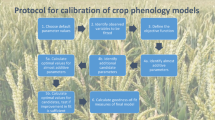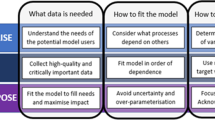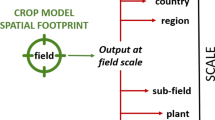Abstract
The International Benchmark Sites Network for Agrotechnology Transfer (IBSNAT) Project has recognized that the application of models depends not only on the availability of models and application software, but also on the availability of data that facilitate model calibration, evaluation and application. IBSNAT, therefore, has devoted considerable attention to developing and clarifying procedures that relate to data acquisition, storage, exchange, and use. For model operation, IBSNAT has emphasized the need for a balanced set of information that includes information on the site where the experiment was conducted, on the weather during the growing cycle, on the characteristics of the soil at the start of the growing cycle, on the management of the crop, and on new cultivar traits. For each of these, IBSNAT has defined a minimum amount of data that is necessary for model operation. This minimum amount of information has been termed a ‘Minimum Data Set’, a phrase that is applicable to data sets for model operation as well as calibration and evaluation. For the latter, data on the date of occurrence of the main phenological events, on yield and its components, and on biomass at final harvest are necessary as a minimum addition to the data for model operation. Within-season measurements of some growth characteristics may also be necessary for calibrating models for new situations. Information from such studies is easily lost unless specific steps are taken to ensure that it is conserved. To facilitate both conservation and use, IBSNAT has developed some simple, standard experiment documentation files that can be established and edited easily, and that can also be transferred directly among workers without the need for ‘retrieval’ from a central database. The widespread use of the data structures developed by IBSNAT would make possible a ‘dispersed’ but nonetheless standard database for model calibration and evaluation, as well as documentation of experiments.
Access this chapter
Tax calculation will be finalised at checkout
Purchases are for personal use only
Preview
Unable to display preview. Download preview PDF.
Similar content being viewed by others
References
Batchelor W D, Jones J W, Boote K J, Hoogenboom G (1994) Carbon-based model to predict peanut pod detachment. Transactions of the American Society of Agricultural Engineers 37: 1639–1646.
Boote K J (1982) Growth stages of peanut (Arachis hypogaea L.). Peanut Science 9: 35–40.
Davies J A, McKay D C (1988) Estimating solar radiation from incomplete cloud data. Solar Energy 41: 153.
Davies J A, McKay D C (1989) Evaluation of selected models for estimating solar radiation on horizontal surfaces. Solar Energy 43: 153.
Fehr W R, Caviness C E, Burmood D T, Pennington J S (1971) Stage of development descriptions for soybeans, Glycine max ( L.) Merrill. Crop Science 11: 929–931.
Geng S, Auburn J, Brandsetter E, Li B (1988) A Program to Simulate Meteorological Variables; Documentation for SIMMETEO. Agronomy Progress Report, University of California, Davis, California, USA.
Godwin D C, Thornton P K, Jones J W, Singh U, Jagtap S S, Ritchie J T (1990) Using IBSNAT’s DSSAT in strategy evaluation. Pages 59–71 in Proceedings of the IBSNAT Symposium: Decision Support System for Agrotechnology Transfer. Part I: Symposium proceedings. Department of Agronomy and Soil Science, College of Tropical Agriculture and Human Resources, University of Hawaii, Honolulu, Hawaii, USA.
Grimm S S, Jones J W, Boote K J, Hesketh J D. 1993 Parameter estimation for predicting flowering date of soybean cultivars. Crop Science 33: 137–144.
Hansen J W, Pickering N B, Jones J W, Wells C, Chan H V K, Godwin D C (1994) WeatherMan: Managing Weather and Climate Data. Pages 137–200 in Tsuji G Y, Uehara G, Balas S (Eds.) DSSAT v3. Vol. 3–3, University of Hawaii, Honolulu, Hawaii, USA.
Huda A K S (1988) Simulating growth and yield responses of sorghum to changes in plant density. Agronomy Journal 80: 541–547.
Hunt L A (1994) Data requirements for crop modelling. Pages 15–25 in Uhlir P F, Carter G C (Eds.) Crop modelling and related environmental data. A focus on applications for arid and semiarid regions in developing countries. CODATA, International Council of Scientific Unions, Paris, France.
Hunt L A, Jones J W, Ritchie J T, Teng P S (1990) Genetic coefficients for the IBSNAT crop models. Pages 15–29 in Proceedings of the IBSNAT Symposium: Decision Support System for Agrotechnology Transfer. Part I: Symposium proceedings. Department of Agronomy and Soil Science, College of Tropical Agriculture and Human Resources, University of Hawaii, Honolulu, Hawaii, USA.
Hunt L A, Jones J W, Hoogenboom G, Godwin D C, Singh U, Pickering N B, Thornton P K, Boote K J, Ritchie J T (1994a) Input and output file structures for crop simulation models. Pages 35–72 in Uhlir P F, Carter G C (Eds.) Crop modeling and related environmental data. A focus on applications for arid and semiarid regions in developing countries. CODATA, International Council of Scientific Unions, Paris, France.
Hunt L A, Jones J W, Tsuji G Y, Uehara G (1994b) A minimum data set for field experiments. Pages 27–33 in Uhlir P F, Carter G C (Eds.) Crop modeling and related environmental data. A focus on applications for arid and semiarid regions in developing countries. CODATA, International Council of Scientific Unions, Paris, France.
Hunt L A, Pararajasingham S (1994) GenCalc. Pages 201–234 in Tsuji G Y, Uehara G, Balas S (Eds.) DSSAT v3. Vol. 3–4, University of Hawaii, Honolulu, Hawaii, USA.
Hunt L A, Pararajasingham S, Jones J W, Hoogenboom G, Imamura D T, Ogoshi R M (1993) GENCALC: Software to facilitate the use of crop models for analyzing field experiments. Agronomy Journal 85: 1090–1094.
International Benchmark Sites Network for Agrotechnology Transfer (IBSNAT) (1986a) Technical Report 1: Experimental Design and Data Collection Procedures for IBSNAT. Second Edition, Department of Agronomy and Soil Science, College of Tropical Agriculture and Human Resources, University of Hawaii, Honolulu, Hawaii, USA.
International Benchmark Sites Network for Agrotechnology Transfer (IBSNAT) (1986b) Technical Report 5: Documentation for the IBSNAT Crop Model Input and Output Files, Version 1. 0, Department of Agronomy and Soil Science, College of Tropical Agriculture and Human Resources, University of Hawaii, Honolulu, Hawaii, USA.
International Benchmark Sites Network for Agrotechnology Transfer (IBSNAT) (1988) Technical Report 1: Experimental Design and Data Collection Procedures for IBSNAT. Third Edition, Department of Agronomy and Soil Science, College of Tropical Agriculture and Human Resources, University of Hawaii, Honolulu, Hawaii, USA.
International Benchmark Sites Network for Agrotechnology Transfer (IBSNAT) (1989a) Technical Report 5: Documentation for the IBSNAT Crop Model Input and Output Files, Version 1. 1, Department of Agronomy and Soil Science, College of Tropical Agriculture and Human Resources, University of Hawaii, Honolulu, Hawaii, USA.
International Benchmark Sites Network for Agrotechnology Transfer (IBSNAT) (1989b) DSSAT v2. 1 User’s Guide, Department of Agronomy and Soil Science, College of Tropical Agriculture and Human Resources, University of Hawaii, Honolulu, Hawaii, USA.
Jintrawet A (1991) A decision support system for rapid appraisal of rice-based agricultural innovations. Ph.D. Thesis, University of Hawaii, Honolulu, Hawaii, USA.
Jones C A (1984) Experimental Design and Data Collection Procedures for IBSNAT. IBSNAT Technical Report 1. Department of Agronomy and Soil Science, College of Tropical Agriculture and Human Resources, University of Hawaii, Honolulu, Hawaii, USA.
Jones J W, Hunt L A, Hoogenboom G, Godwin D C, Singh U, Tsuji G Y, Pickering N B, Thornton P K, Bowen W T, Boote K J, Ritchie J T (1994) Input and output files. Pages 1–94 in Tsuji G Y, Uehara G, Balas S (Eds.) DSSAT v3. Vol. 2–1, University of Hawaii, Honolulu, Hawaii, USA.
Lancashire P D, Bleiholder H, Van den boom T, Langeluddeke P, Strauss R, Weber E, Witzenberger A (1991) A uniform decimal code for growth stages of crops and weeds. Annals Applied Biology 119: 561–601.
Lemon E R (1977) Final Report of the USDA Modeling Coordinating Committee. USDA-ARS, USA.
Matthews R B, Hunt L A (1994) GUMCAS: model describing the growth of cassava (Manihot esculenta L. Crantz ). Field Crops Research 36: 69–84.
Nix H A (1980) Strategies for crop research. Proceedings of the Agronomy Society of New Zealand 10: 107–110.
Nix H A (1984) Minimum data sets for agrotechnology transfer. Pages 181–188 in Proceedings of the International Symposium of Minimum Data Sets for Agrotechnology Transfer, 21–26 March 1983, ICRISAT Center, India, Patancheru, India.
Ogoshi R M (1994) Determination of genetic coefficients from field experiments for CERES-maize and SOYGRO crop growth models. Ph.D. Thesis, University of Hawaii, Honolulu, Hawaii, USA.
Richardson C W (1985) Weather simulation for crop management models. Transactions of the ASAE 28 (5): 1602–1606.
Ritchie J T (1981) Soil water availability. Plant and Soil 58: 327–338.
Ritchie J T (1993) Genetic specific data for crop modeling. Pages 77–93 in Penning de Vries F W T, Teng P, Metselaar K (Eds) Systems approaches for agricultural development. Kluwer Academic Publishers, Dordrecht, the Netherlands.
Ritchie J T, Godwin D C, Singh U (1990) Soil and weather inputs for the IBSNAT crop models. Genetic coefficients for the IBSNAT crop models. Pages 31–45 in Proceedings of the IBSNAT Symposium: Decision Support System for Agrotechnology Transfer. Part I: Symposium proceedings. Department of Agronomy and Soil Science, College of Tropical Agriculture and Human Resources, University of Hawaii, Honolulu, Hawaii, USA.
Ritchie S W, Hanway J J (1982) How a Corn Plant Develops. Special Report No. 48 ( Revised) Iowa State University, Ames, Iowa, USA.
Schroedter H (1983) Meteorological problems in the practical use of disease-forecasting models, EPPO Bulletin 13: 307.
Selirio I S, Brown D M, King K M (1971) Estimation of net and solar radiation. Canadian Journal of Plant Science 51: 35.
Sexton P J, White J W, Boote K J (1994) Yield-determining processes in relation to cultivar seed size of common bean. Crop Science 34: 84–91.
Soil Survey Staff (1975) Soil Taxonomy: A basic system of soil classification for making and interpreting soil surveys. Soil Conservation Service, U.S. Department of Agriculture Handbook 436, U.S. Government Printing Office, Washington, D.C.
Tichelaar B W, Ruff L J (1989) How good are our best models? Eos, May 16.
Uhlir P F, Carter G C (Eds.) (1994) Crop modeling and related environmental data. A focus on applications for arid and semiarid regions in developing countries. CODATA, International Council of Scientific Unions, Paris, France.
Vanderlip R L, Reeves H E (1972) Growth stages of sorghum (Sorghum bicolor ( L.) Moench). Agronomy Journal 64: 13–16.
World Meteorological Organization (1983) Guide to Agricultural Meteorological Practices. 2nd edition, World Meteorological Organization, Geneva, Switzerland.
Zadoks J C, Chang T T, Konzak C F (1974) A decimal code for the growth stages of cereals. Eucarpia Bulletin 7.
Author information
Authors and Affiliations
Editor information
Editors and Affiliations
Rights and permissions
Copyright information
© 1998 Springer Science+Business Media Dordrecht
About this chapter
Cite this chapter
Hunt, L.A., Boote, K.J. (1998). Data for model operation, calibration, and evaluation. In: Tsuji, G.Y., Hoogenboom, G., Thornton, P.K. (eds) Understanding Options for Agricultural Production. Systems Approaches for Sustainable Agricultural Development, vol 7. Springer, Dordrecht. https://doi.org/10.1007/978-94-017-3624-4_2
Download citation
DOI: https://doi.org/10.1007/978-94-017-3624-4_2
Publisher Name: Springer, Dordrecht
Print ISBN: 978-90-481-4940-7
Online ISBN: 978-94-017-3624-4
eBook Packages: Springer Book Archive




